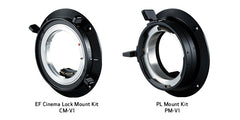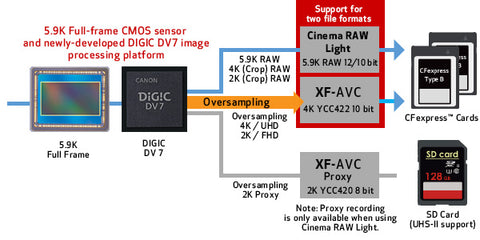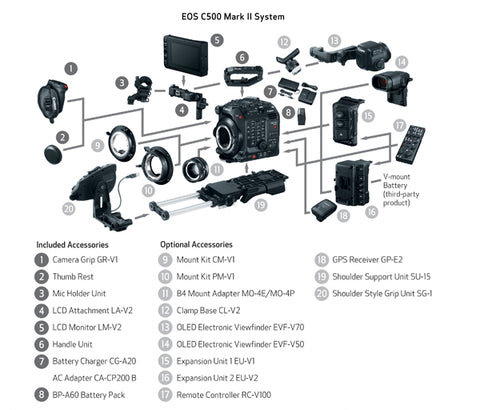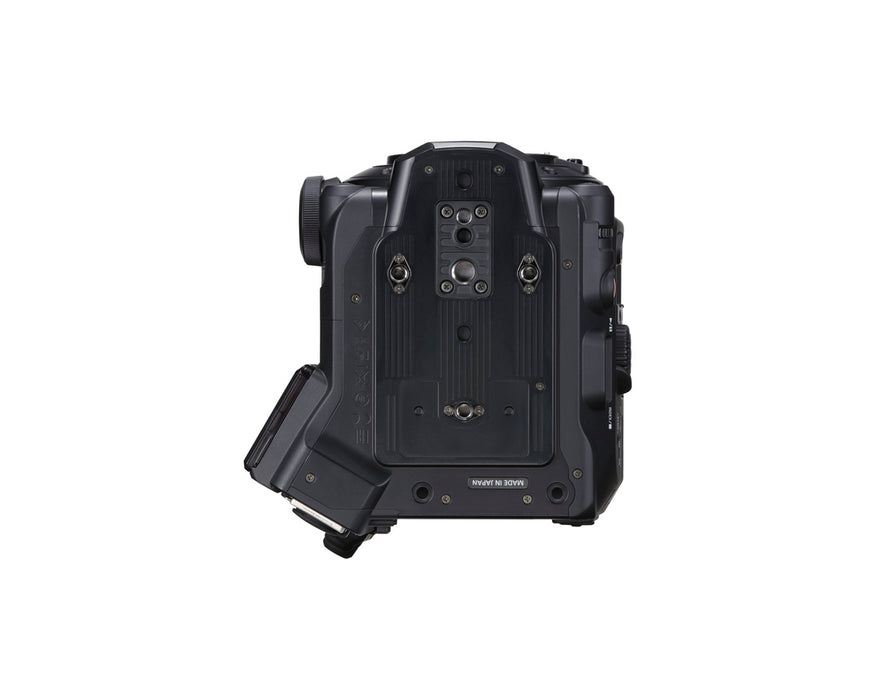

Impressive usability and imaging power combine in the Canon EOS C500 Mark II, the customizable full frame cinema camera that’s built for creative freedom.
The lightweight body comes equipped with Canon's 5.9K full-frame CMOS sensor capable of over 15 stops of dynamic range. The newly developed DIGIC DV 7 Image Processor expands functionality and flexibility by enabling features such as 5.9K recording, internal recording of Canon Cinema Raw Light and Dual Pixel Autofocus.
The Cinema EOS C500 Mark II is the perfect expression of form and function, exceptionally adaptable to virtually any production with its modular design. Three expansion units and user changeable lens mounts enable operators to build their ideal cinema system.
5.9K Full Frame CMOS Sensor, with support for Super 35mm and Super 16mm crop modes
The Cinema EOS C500 Mark II features Canon’s high-resolution 5.9K (38.1 x 20.1mm) Full Frame CMOS sensor, which offers exceptional low noise and a broad range of tonality with over 15 stops of dynamic range. The sensor’s expansive native cinema gamut goes beyond that of current standards, including ITU-R BT.2020 and DCI-P3, helping the EOS C500 Mark II achieve more natural skin tones and allowing for greater freedom in color grading in both SDR and HDR productions.
The Full Frame sensor is capable of capturing footage in a wide variety of aspect formats, including DCI-4K, UHD and Anamorphic Widescreen. The Cinema EOS C500 sensor supports both anamorphic and spherical lenses. In addition to full-frame, the sensor can also be paired with conventional Super 35mm and Super 16mm lenses using appropriate sensor crop modes, lens mount and adapter.
User Changeable Lens Mounts which gives users freedom to use the lenses they desire
User interchangeable lens mounts and an available B4 mount adapter gives operators the freedom to make bold creative choices based on the subject matter.
The EOS C500 Mark II ships with an EF Mount that can be user swapped to an optional Locking EF (EF-C) or PL mount. Each mount swaps easily by simply removing four M3 hex screws. A shim set is provided with each mount kit in order to adjust back focus for the precision in focusing accuracy that professionals rely on.
*Dependent on the mount the user has in place
Newly developed DIGIC DV 7 Image Processor, which powerfully processes high-resolution image data
The EOS C500 Mark II uses a newly developed DIGIC DV 7 Image Processor that takes the extensive RAW information captured from the 5.9K imaging sensor and processes it for output. DiG!C is also the engine behind features such as high frame rate recording, Dual Pixel Auto Focus, Cinema Raw Light Recording, HDR(PQ and HLG) output, electronic image stabilization, proxy recording and oversampling 5.9K processing.
Canon Cinema RAW Light and XF-AVC Recording
Thanks to the powerful DIGIC DV 7 image processing platform, the EOS C500 Mark II can record Cinema RAW Light directly to onboard CFexpress cards, which keeps the data-rich signal captured by the 5.9K full-frame sensor intact. Cinema RAW Light offers plenty of freedom for grading in file sizes that are about 1/3 to 1/5 the size of Cinema RAW, offering a great combination in terms of codec efficiency and quality.
Proxy Recording
Higher resolution, greater bit depths and faster frame rates provide versatility and greater image quality but come at the cost of much larger file sizes. Proxy files can greatly speed up the editorial process by providing a lower bandwidth alternative for the initial file sharing and edits.
Canon’s powerful, high-speed DIGIC DV 7 image processor makes it possible for the EOS C500 Mark II to simultaneously record 2K Proxy files. Cinema RAW Light (5.9K, 4K Crop, or 2K (Crop)) can be recorded to the internal CFexpress card while an XF-AVC 2K 4:2:0 8-bit Proxy can be recorded directly to an internal SD card.
Compatibility with EF and PL Lenses*
With optional mount kits, users can swap from EF to Locking EF-C or PL mounts on their own.
PL lenses are a cinema legacy. With a wide breath of options available to cinematographers choosing a lens is an important part of the creative process. The EOS C500 Mark II’s interchangeability now makes it possible to take any PL lens and pair it with Canon’s state-of-the-art sensor to meet the needs of any project.
Using Canon’s EF still lenses offer remarkable new possibilities for cinematographers including the use of specialty lenses like the fisheye zoom, tilt-shift and super-telephotos.
The amount of viable lens options can be further increased through an optional B4 lens mount adapter. This adapter is available for the PL or EF mount allowing 2/3” lensing options to be used with the camera.
* Does not include 4 Pin XLR AC Adapter
Anamorphic Lens Support
The EOS C500 Mark II offers cinematographers anamorphic lens support. Users can now achieve wide cinematic looks and oval bokeh particular to anamorphic glass. It is a distinctly cinematic palette that is within reach for your next project.
Electronic Image Stabilization
The EOS C500 Mark II is the first Canon Cinema EOS camera to feature built-in five-axis electronic IS that works with almost any lens including anamorphic.
Modular Design with three available Expansion Units allows a high level of connectivity and interoperability
A new modular design allows productions to optimize and customize the EOS C500 Mark II to specific shooting needs. Accessories and expansion units can be easily attached to provide different levels of functionality. The camera is equally at home fully rigged with a large zoom lens, FIZ unit, audio accessories and rangefinder as it is stripped down flying on a drone.
4.3” LCD Touch screen Monitor LM-V2
The new LM-V2 4.3” LCD Monitor is an easy to view touch panel with approx. 2.76 million dots. The monitor easily attaches to the EOS C500 Mark II using included accessories and can be adjusted to different viewing positions. In addition to image framing and visual confirmation of camera settings, attached controllers make it easy to access and change camera settings.
Dual Pixel CMOS AF with support for Touch AF and Face Detection AF
The Cinema EOS C500 Mark II features Canon’s Dual Pixel CMOS AF Technology. For DAF, each pixel in the camera’s CMOS sensor is configured with two photodiodes. Two independent image signals can then be detected at each photosite and compared using phase-difference to provide autofocus with compatible lenses. DAF can survey the scene and recognizes not only whether the subject is in focus or not, but in which direction (near or far), and by how much. DAF also powers the intuitive Focus Guide for users who prefer to focus manually but enjoy the positive feedback DAF provides through the guide interface.
DAF technology can also be used to aid in manual focus. Focus information is translated to an on-screen guide that conveys to the operator the subjects current focus and direction to move in order achieve focus. When sharp focus is achieved the indicator turns green as a clear indication.![]()
TDAF can simulate a focus pull using preset locations. After setting two separate focus locations on screen, the cameras set button can be used to alternate between the two focus points. The focus racking effect can be fine-tuned by adjusting AF tracking speed and response. You can also set two different Focus Guide positions and use the SET button to toggle between the two focus points.
![]()
Canon Log 2 and 3 Support
The EOS C500 Mark II supports Canon Log 2 and Canon Log 3 Gamma. In post-production, Canon Log is designed to reproduce the entire tonal range that the CMOS image sensor is capable of. Log workflows provide the user with higher dynamic range, more highlight and shadow retention, and more flexibility in grading.
Canon Log 2 provides the largest dynamic range and image detail. While Canon Log 2 provides the most post-production flexibility and full dynamic range of the sensor, it typically requires more time in color correction.
For users looking for most of the benefits of log workflow, but with shorter turnaround times, Canon Log 3 provides an alternative with only a slightly reduced dynamic range of 14 stops.

4 Channel Audio Recording
With Expansion Unit EU-V2, the EOS C500 Mark II supports up to 4-channel audio recording. Audio input from the camera’s internal microphone, mini mic port, and XLR ports can be assigned to the 4 different audio channels. This flexibility allows a wide range of audio devices to be connected and mixed directly on the camera.
Support for Custom User LUTs
Users can upload and apply custom LUTs to the EOS C500 Mark II. LUTs can be assigned to specific output terminals and the LCD or viewfinder. Clients can be viewing one LUT, while production works from another, giving different production roles the ability to customize the look of the image to their needs.
| Glazer's SKU | 51192 | |||||||||||||||||||||||||||||||||||||||||||||||||||
|---|---|---|---|---|---|---|---|---|---|---|---|---|---|---|---|---|---|---|---|---|---|---|---|---|---|---|---|---|---|---|---|---|---|---|---|---|---|---|---|---|---|---|---|---|---|---|---|---|---|---|---|---|
| Manufacturer | Canon | |||||||||||||||||||||||||||||||||||||||||||||||||||
| MFG SKU | 3794C002 | |||||||||||||||||||||||||||||||||||||||||||||||||||
| Product Specs |
|













